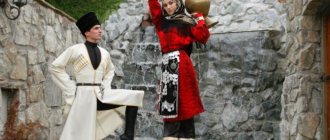Azerbaijan is one of those countries where national traditions that have developed over the centuries-old history of this people are deeply revered and sacredly observed. They accompany every representative of an ancient nation born on this land from the moment of birth until the end of life. The traditions and customs of Azerbaijanis are original and sometimes contradictory, but they are always based on Muslim moral norms in combination with ancient cults of national history.
Azerbaijanis: history and modernity of the Caucasian people
Arriving in Azerbaijan, you will find yourself in a country where the hot sun reigns and you can see magnificent buildings (be they architectural monuments or modern houses). And, without a doubt, you will be captivated by the Azerbaijanis, who are part of the family of Caucasian peoples and rightfully proud of their history and culture, with their temperament. Without them it is impossible to imagine either the Caucasian flavor or the post-Soviet space itself.
Origin and history of the people
What they don’t tell about Azerbaijanis! Sometimes you can even hear the opinion that these people cannot be considered Caucasian, because they have something in common with the peoples of Asia. However, these are idle fictions. They are the indigenous people of the Caucasus, like other ethnic groups inhabiting this region.
Historians have come to the conclusion that the origin of the people is connected with people from Caucasian Albania, a large state located in the eastern part of the Caucasus in the 2nd-1st centuries BC. Then the population of this country began to mix with the Huns, Cimmerians and other nomadic tribes.
Persia also had a significant influence on the formation of the ethnic nation of Azerbaijanis. In the first centuries AD, Persia was ruled by the Sassanid dynasty, which expanded its influence into the eastern regions of Transcaucasia.
We must not forget about the later influence of the Seljuk Turks, who came to these lands in the 11th century. As a result, the local population was first subjected to the influence of Persian culture, and then to the process of Turkization. Thus, the Azerbaijani people have a rich history and it is closely connected with the history of neighboring states.
Turkic tribes constantly migrated throughout the region of Asia Minor, from the early Middle Ages to the 15th-16th centuries. All this could not but affect the local population, who only later began to realize their ethnic identity. Some researchers believe that modern Azerbaijanis are the descendants of a specific tribe with Turkic roots.
This hypothesis is shattered by other evidence, including cultural heritage, as well as written sources. Therefore, today we can say that the appearance of Azerbaijanis was influenced by a variety of tribes - Arab, Turkic, Iranian.
And at the same time, they still remain an indigenous ethnic group of Transcaucasia, since their history has precisely Caucasian roots. This is proven by the numerous traditions and diverse customs of Azerbaijanis, which find their origins in both Iranian and general Caucasian culture.
In the 18th century, the powerful Persian Safavid dynasty ended, resulting in the formation of a number of khanates with a semi-independent status. At the head of these small Transcaucasian principalities were representatives of Azerbaijani local dynasties. However, they were never able to form into a single state, since they were still under the strong influence of the Persians.
And later, already in the 19th century, Russian-Persian military conflicts began, which led to the fact that they were delimited by the regions of their residence. This border ran along the Araks River, as a result of which the northern parts of Azerbaijan fell under the influence of Russia, and the southern parts went to the Persians. And if earlier the Azerbaijani elites had a strong influence on the processes taking place in Persia, then after such a division this influence disappeared.
Historians recognize that their statehood was formed only after the October Revolution took place in Russia and national republics began to be created. Soviet power gave modern Azerbaijan borders and a state-legal framework.
When the USSR collapsed, all Soviet republics gained independence, including Azerbaijan. The date of independence is October 18.
Number
The approximate number of Azerbaijanis who live around the world today is 50 million people. Surprisingly, most of them live in Iran - according to some sources, about 30 million. Next on the list is, in fact, Azerbaijan - 8.2 million. According to the 2010 census, the number of Azerbaijanis in Russia is 603,000. Experts believe that in fact there are three times more of them - about 2 million. The following states became the homeland for representatives of the nation:
- Türkiye - 3 million;
- USA - 1 million;
- Egypt - 850 thousand;
- Iraq - 800 thousand;
- Georgia - 600 thousand;
- Ukraine - 500 thousand;
- Afghanistan - 430 thousand;
- Kingdom of Jordan - 410 thousand;
- Pakistan - 350 thousand;
- Germany - 300 thousand;
- India - 300 thousand
Language and religious denomination
The Azerbaijani language is of Turkic origin; its formation was also influenced by Arabic and Persian languages. However, their language also has other phonetic connections - linguists find similarities in it with the Kumyk and even Uzbek languages.
Currently, Azerbaijani is spoken by about 99% of the country's residents. Since the same language is widespread in the north of Iran and Iraq, this brings ethnic groups together and allows for the accumulation of cultural ties.
As for their literary language, it was fully formed only after these territories were annexed to Russia. However, even before the Russian period of history, the literary language of Azerbaijanis gradually developed in Shirvan and the southern regions of Azerbaijan.
As for religion, the majority of them are Muslims. Almost 90% of those who profess Islam in Azerbaijan are Shiites, but those who consider themselves Sunnis also live here. This is another manifestation of Persian influence.
The modern faith of Azerbaijanis can be very different, since the country has complete tolerance towards religion.
Here you can meet both Christians and followers of other religions. A person living on the territory of this country has the right to choose which religious movement to follow, and no one has the right to influence his beliefs.
Enos territorial issues
Since Azerbaijanis are a very diverse ethnic group, representatives of the people are found not only in this region, but also in other countries of the world. Moreover, the division of their lands between Russia and Persia has led to the fact that today there are between 15 and 20 million people living in Iran. This is much more than the population of Azerbaijan itself - about 10 million people live there, according to government statistics.
It was they who had a serious influence on the development of healthy nationalism in modern Iran. After the Second World War, residents of the Republic of Azerbaijan in the USSR and Azerbaijanis in Iran had the opportunity to communicate closely. This inner unity can still be seen today.
Azerbaijanis and Dagestanis have close ties in Russia. In 2000, the Dagestani authorities included Azerbaijanis among the indigenous peoples of the Republic of Dagestan, although this ethnic group is classified as small in number. Basically, they live in the southern parts of the republic, and it is in Derbent and its region that the largest number of them live. In the republic they make up no more than 5% (or even less) of the entire Dagestan population.
A serious conflict arose at one time between the Azerbaijanis and the Armenians; it concerned the territory of Nagorno-Karabakh, located in the east of the Armenian Highlands. Historically, this territory belonged to Armenia, but the Paris Peace Conference in 1920 assigned this region to Azerbaijan.
Since then, the Azerbaijanis have considered Karabakh theirs, which led, after the collapse of the USSR, to a territorial conflict that resulted in full-fledged military action on both sides.
Only in 1994 did Armenia and Azerbaijan conclude a truce, although the tense situation in this region is still observed today. No matter how much the Azerbaijanis claim that they are the legal owners of Nagorno-Karabakh, the Armenians are not going to recognize this.
Culture and traditions of the Azerbaijani people
Such a colorful people as the Azerbaijanis cannot but have their own culture - and it is rooted in history. The cultural heritage includes not only their folk traditions, but also many crafts - carpet weaving, artistic stone and bone processing have long been developed here, and gold items created by folk goldsmiths were widely known.
Speaking about the culture of Azerbaijanis, one cannot help but recall such traditions as holidays and folk ritual performances. First of all, these are wedding customs. In many ways, a traditional wedding is similar to those wedding rituals that are practiced by other Caucasian ethnic groups. Not only regular matchmaking is common here, but also preliminary matchmaking, during which the parties enter into an initial agreement on a future alliance.
In many ways, Azerbaijani weddings resemble classical Islamic ritual rules. Here the bride's face is covered with a scarf or a thin veil, and the wedding feast is held both in the house of the groom and in the house of the bride.
Other holidays among Azerbaijanis are always no less colorful. You can’t do without national costumes, as well as songs and fiery dances.
Azerbaijani folk music always uses ethnic musical instruments. And modern motifs in many ways still resemble folk traditions, which is why the songs of Azerbaijanis have a special tonality and are largely stylized after the creativity of the ashugs.
National flavor can always be seen in the art of dance. If we consider the folk dance of Azerbaijanis, we cannot help but note its unique rhythmicity. They can be either overtly rhythmic or smooth.
It is on strict adherence to rhythm that the entire pattern of the dance, its structure, is built. Those dances that have roots in ancient traditions often bear the names of plants or animals characteristic of Azerbaijan. There are many videos of them performing their dances passionately.
Speaking about the national costumes of Azerbaijanis, it is necessary to mention their correlation with the cultural and geographical location of the region itself. Men wear a caftan-arkhalyg, and under it they put on an undershirt. A man's suit also includes outerwear for cold weather - after all, in the foothills of the Caucasus in winter, only a burka or a fur coat made of tanned lamb skins can save you.
If you look at the photos of Azerbaijanis, you can see that they often wear a Circassian coat with gazyrs. The women's costume is no less bright and original. These are the top and bottom dresses, as well as the obligatory veil. A mandatory component of women's clothing has always been a belt or sash - such belts could be richly decorated with gold and embroidery, which could say a lot about the status of a woman.
Another custom concerning the appearance of women is the traditional coloring of hair and nails with henna. Henna dyeing is also a legacy of the influence of Persian culture.
Men
Since ancient times, Islamic norms have determined the dominant role of men. His task was to provide the family with housing and finances. The man did not take part in household chores and raising children. His word was law for his wife and was not disputed; women were treated with disdain. Men were allowed polygamy, levirate and sororate were practiced, and adultery was allowed. Azerbaijani men are distinguished by a calm and firm character, maintain a serious expression on their faces, and behave modestly and with dignity. They quickly make decisions and follow them clearly, without allowing doubts. They are sensitive to attacks on the honor of the family or their own, they keep their word, public opinion, status, and appearance are of particular importance.
Highlights
The large scale of the wedding feast is impressive. We can say that they begin to celebrate the union even at the matchmaking stage. This whole grandiose event requires significant expenses, so they begin to postpone children’s wedding in advance.
All pre-wedding efforts are divided into several stages:
- Search and selection of the bride by the groom.
- Matchmaking takes place in two stages.
- Engagement ceremony.
- Pre-wedding preparation with a lot of rituals.
- Wedding celebration.
- Post-wedding rituals.
Each item requires a serious approach and preliminary study of information about future relatives.
The groom chooses the bride, shows the girl he likes to his parents, and only after their approval begins the search for a matchmaker who will represent his interests in the bride’s family.
Girls in this country do not communicate with guys, always being in female company only. Therefore, often there is practically no time left to get to know the groom.
The decision always remains with the girl’s father; he, as the head of the family, determines whether the groom is suitable for his daughter. An important role here is played by the situation of the guy himself and his family, both financial and social.
Choosing a future wife
Any guy first of all evaluates a girl’s appearance. And his parents are making inquiries about her and her family. And if they are not satisfied with something about the girl chosen by their son, then they immediately tell the young man about it. Of course, the guy will always listen to the opinions of his family, because they won’t give bad advice.
If the chosen one is approved by the parents, the groom asks one of his relatives to find out as much information about her as possible. The named matchmaker makes inquiries not only to the bride herself, but also to her family. Particular attention is paid to the girl’s financial situation; it is used to judge whether the groom will be able to satisfy the needs of his future wife.
The girl's qualities are revealed:
- How does she behave in public, is she modest.
- How economical she is.
- Culinary skills are assessed.
- Health status.
- Education.
The most interesting thing is that the age of the intended bride does not matter. According to the customs of Azerbaijani weddings, a girl can be married off at the age of 14. After the initial stages have been settled, one of the relatives is sent to the girl’s house. If consent is received, then they move on to matchmaking.
Matchmaking
The ceremony of matchmaking the bride takes place in two stages.
- Initial small matchmaking.
- Big matchmaking.
Traditionally, the mother comes to the bride for small matchmaking, accompanied by three other women, this could be the eldest daughter or sister. Who else but a mother can determine whether a girl is suitable for her son, and whether she will take care of him as well.
In some cases, the father of the groom comes and talks with the bride’s parents, introduces himself and vaguely hints at a possible marriage. Thus preparing the ground for the future delegation of matchmakers.
The big matchmaking is already celebrated more magnificently. The groom's father, accompanied by his relatives or respected elders, comes to negotiate. He already speaks directly about his son’s desire to marry a girl. Traditionally, it is customary to refuse the first time, citing the fact that the father wants to know his daughter’s opinion.
The girl's silence means consent to the marriage. The arriving women from the groom's side go to the bride, while the men discuss everything among themselves. The girl’s opinion is asked, and having received a positive answer, you can proceed to setting a date for the official matchmaking.
The event takes place in the bride’s house very magnificently, but the hero of the occasion is traditionally absent. She is staying with a friend, the girl’s mother is at the event, but she is silent, thereby showing her sadness in connection with her daughter’s future departure from her father’s house.
After the father's blessing, the bride's sister hurries to tell the good news. The bride herself returns home only after the matchmakers leave. It is considered a good omen if a girl spends the entire evening crying.
Engagement ceremony
The engagement ceremony also takes place in two stages:
- Small engagement.
- Big engagement.
The groom himself and his friends come to the small engagement party. The bride is in the company of two or three dozen friends. The groom's official representative puts the ring on the girl's finger, and he also covers the girl's head with a scarf.
Then he must eat half of any sweet served by the bride, and give the other half to the groom.
As soon as the ceremony is over, the bachelorette party begins, the girl’s friends shower her with congratulations and parting words, sitting at the sweet festive table. The small engagement takes place within a month after the matchmaking.
A couple of months later there is a big engagement party. This big event requires careful preparation, and not only relatives, but also friends and neighbors are invited to it. The groom's relatives can also provide the necessary food for the table. Only onions are not sent, being considered a bad omen symbolizing bitterness in family life.
Various necessary things are presented to the bride as gifts:
Gifts are usually given on silver trays if they are small. When large gifts are given, they are placed in chests and tied with a red ribbon.
The only gifts not given from relatives are shoes, which are later presented by the mother-in-law personally.
Traditional culinary dishes
It is difficult to imagine the national traditions of Azerbaijan in isolation from the national cuisine of this distinctive country. Despite the large number of borrowings, it is famous for its original dishes. One of the important features of local cuisine is the widespread use of lamb, fat tail fat, herbs, a large number of spices, sour milk, fruits and vegetables.
Almost always on the table there are salads from fresh vegetables, which are usually finely chopped, seasoned with fermented milk products or all kinds of spices, and most importantly, generously seasoned with herbs. The following are used as additives to many dishes:
- narsharab (sauce based on pomegranate juice);
- sumac;
- gora and abgora (unripe grapes and juice obtained from them);
- dried dogwood fruits;
- dushab (sauce based on evaporated mulberry or grape juice).
Bakery products occupy a special place in traditional cuisine. Lavash, which is baked in a tandoor or saj, is especially popular. The eldest woman in the family must knead the dough, and the daughter-in-law rolls out the cakes. They are so thin that they cook in one minute. For the most part, Azerbaijanis are partial to sweets, especially pastries and a variety of fruit jams, which are usually served to guests. The traditional cuisine of the country includes about 50 different recipes for sweets.
The range of traditional dishes of Azerbaijani cuisine is so huge that any guest of the country will be able to find something to their liking. Considering that just one pilaf has up to 200 different cooking methods, you can find about 2,000 varied and interesting dishes here.
Basic preparations for the wedding
After the engagement, both families gather to discuss all the necessary components of the future ceremony:
- Guest list.
- Menu on the table.
- Music, etc.
Usually, several months pass from engagement to wedding, because everything needs to be carefully planned and prepared. Also during this period, a number of other rituals are carried out, in which the girl is presented with unusual gifts by the groom’s relatives:
- Hand-sewn and embellished dresses.
- Red scarf;
- Decorations;
- Ram with henna-dyed horns.
- Henna dye for applying pre-wedding patterns on hands and feet.
The bride's dowry and belongings are also transported to the groom's house before the wedding. Then the bride's friends come to the groom's house to restore order and decorate the house. The girl’s mother-in-law rewards them for their efforts.
Another unusual ritual is the selection of the bride’s mentor “brocade bichini”, a few days before the wedding.
Wedding ceremonies
The wedding begins at the bride's house and lasts the whole day. Traditional Azerbaijani wedding songs are played. But only relatives of the groom can dance with the bride. All other guests must pay by placing money in the cauldron before starting to eat. In the evening, the groom's relatives leave the bride's house, and the feast continues without their participation.
Seeing off the bride is also a very beautiful ceremony. The girl sits in a locked room, waiting for the groom's guests to receive the treasured key by giving a gift. Then the parents tie a red ribbon around the girl’s waist, blessing her for family life, and put on a scarf.
Congratulations at an Azerbaijani wedding can also come in the form of a beautiful toast with deep meaning, or the performance of a traditional song or dance. Azerbaijani dances at weddings are incredibly beautiful. Traditional songs are played at the festival, so every Azerbaijani knows how to dance to them from childhood. A special program is drawn up, which includes both songs and dances.
Housing
In the mountainous regions, Azerbaijanis settled in crowded settlements located on terraces. Houses were built from untreated stone or raw brick, covered with turf or had gable roofs. Often they stood so close to each other that it was difficult for two riders to pass each other.
On the plains they practiced a chaotic arrangement of houses surrounded by estates or small courtyards. They were built from the same materials, multi-room and two-story. On the first one they housed livestock and utility rooms, on the second one they lived, supplementing it with open terraces. They were used as workshops or for drying fruits. Later, wooden houses with a gable roof appeared. The attic was used for storing supplies or raising silkworms. They slept on mats right on the floor: during the day they were rolled up and put away. The home was heated by a hearth, such as a fireplace; in the cold season, the stoves were additionally heated.











